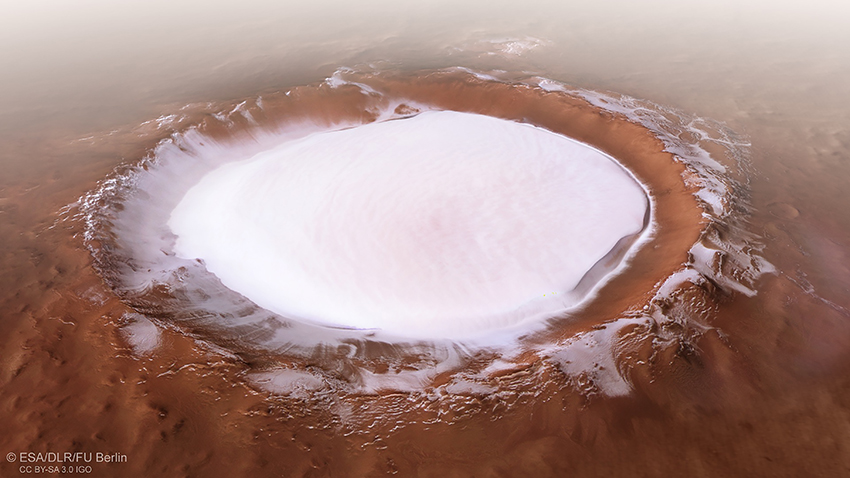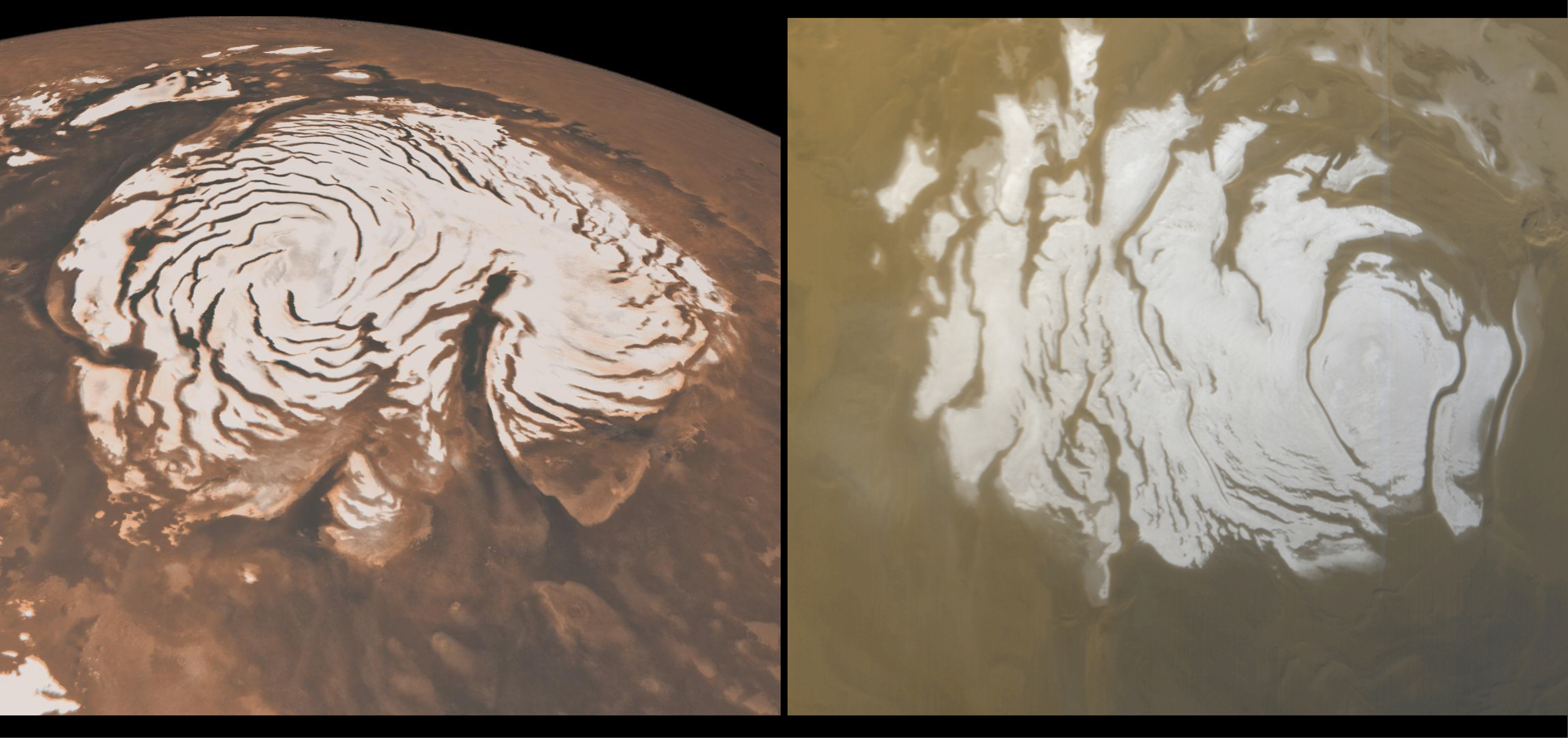Polar ice caps may reveal climate history of Mars
05-18-2023

Purdue scientists publish findings that Mars’ polar ice caps may provide records of multiple different geological eras
Much like the Earth, Mars’ poles are cold and icy. The Martian ice caps have neighboring craters, formed from impacts by meteors, much like the craters you might see on Earth’s Moon. Near the poles, many of these craters are also filled with ice. How did that ice get there? Was it deposited all at the same time? These questions are what a team of scientists at Purdue University Department of Earth, Atmospheric and Planetary Sciences (EAPS) have set out to answer. They use radar data collected by a spacecraft orbiting Mars to unlock these icy time capsules’ hidden historic secrets.
The team, led by Riley McGlasson, 3rd year PhD candidate with Purdue EAPS, recently published their findings, “Varied Histories of Outlier Polar Ice Deposits on Mars,” in American Geophysical Union’s JGR: Planets. They found that ice deposits in the north look similar to each other in radar subsurface data, which means that all the ice may have been deposited in the same timeframe and under similar climate conditions. However, the radar data from the south pole seems to have two populations of deposits, which implies the ice there may have been formed under at least two different environments. These differences in the polar ice can help establish records of climate change on Mars.
Studying the climate history of Mars is important because it may also give clues as to the climate history of Earth and other planets. According to McGlasson, Mars is an excellent place to study how a planet’s changing orbit and tilt affects climate, because it doesn’t have many of the complicating factors that are on Earth, like humans, or biology in general. Studying ice cores on Earth gives scientists historical insights because elements of the environment are trapped within the ice like a time capsule. The Purdue team uses data of Martian ice in a similar way as terrestrial ice cores to learn about Mars’ climate over time.
The team consisted of McGlasson, her advisor, Dr. Ali Bramson, Assistant Professor of Purdue EAPS, Dr. Mike Sori, Assistant Professor of Purdue EAPS, and Dr. Gareth Morgan, Senior Scientist at the Planetary Science Institute. The work relied heavily on radar observations from the Shallow Radar (SHARAD) instrument onboard NASA’s Mars Reconnaissance Orbiter, which has been gathering data on the red planet since 2006. The SHARAD instrument was provided to NASA by the Italian Space Agency.
“Earth and Mars have seasons because of how the planets are tilted. This tilt affects where, when, and how sunlight hits the surface of a planet, and therefore affects where ice is stable. Mars’ tilt changes more substantially than Earth’s, causing more extreme ice ages on the red planet,” says Bramson.
“By gaining a better understanding of this climate controller (tilt and orbit), we can better understand how other factors on Earth interact with these large-scale changes,” McGlasson says. “Ice cores on Earth are a very important record of our climate, going back millions of years. We can see these large ice caps on Mars, and having a remote sensing tool like radar that allows us to see deep within these deposits opens up our ability to access what could be a very robust record of Mars’ past climate.”

“These outlying crater ice deposits may or may not have formed at the same time as the polar caps,” says McGlasson. “Like scientists on Earth use ice cores to analyze how our climate has changed over time, radar observations of ice on Mars can penetrate deep into the ice to look for similar climate records. In this study, we used radar observations to analyze the history of the outlying crater deposits and find that the northern deposits may have had a similar history to the north polar cap, while the southern deposits may record multiple different eras and/or causes of deposition. As it orbits, SHARAD transmits radio waves down to the surface. As these waves hit boundaries between different materials, like the air/surface boundary, or subsurface interfaces between a dusty layer and a layer of clean ice, part of the signal bounces back and is received by SHARAD. The resulting observations are called radargrams, and essentially show a 2D cross-section of the material underneath the spacecraft’s orbit.”
The craters that exist beside the poles also give clues as to the climate history of Mars. Because they are filled with ice that isn’t associated with the large ice masses at the poles, scientists have questioned if the ice is from a similar time frame as when the polar ice was formed, or if the ice was deposited at different geological eras entirely.
“We are trying to figure out if the ice in the craters is the same as the ice in the larger ice mass, or if it is different. Answering this question can tell us about if there were multiple processes that facilitated the growth of these deposits, or if they all exist as a result of the same, more global-scale process,” says McGlasson. “This work presents a hypothesis: that perhaps multiple events or factors contributed to the deposition of these deposits, rather than them all being a result of the same thing at the same time. In order to test this theory further, it will require a more quantitative analysis of the radar observations, as well as analyses of other kinds of datasets.”
This research was funded in part by the NASA Mars Data Analysis Program (MDAP) Grant 80NSSC20K0935.
About the Department of Earth, Atmospheric, and Planetary Sciences at Purdue University
The Department of Earth, Atmospheric, and Planetary Sciences (EAPS) combines four of Purdue’s most interdisciplinary programs: Geology & Geophysics, Environmental Sciences, Atmospheric Sciences, and Planetary Sciences. EAPS conducts world-class research, educates undergraduate and graduate students, and provides our college, university, state and country with the information necessary to understand the world and universe around us. Our research is globally recognized, our students are highly valued by graduate schools, employers, and our alumni continue to make significant contributions in academia, industry, and federal and state government.
Writer: Cheryl Pierce, Communications Specialist
Contributors: Riley McGlasson, 3rd year PhD candidate and Dr. Ali Bramson, Assistant Professor of Purdue University Department of Earth, Atmospheric, and Planetary Sciences (EAPS)
Side by side images by: NASA /JPL-Caltech/MSSS
Lead image by: ESA/DLR/FU Berlin, CC BY-SA 3.0 IGO. This image from ESA’s Mars Express shows Korolev crater, an 82-kilometer-across feature found in the northern lowlands of Mars.